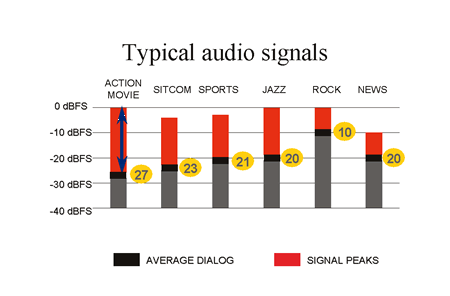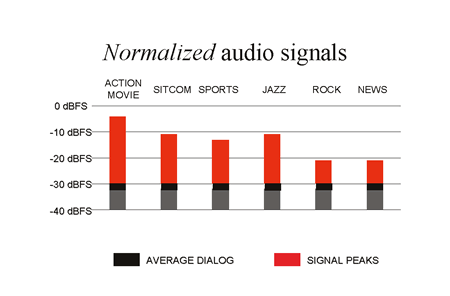Why are TV commercials so loud?
June 5, 2008
As an avid audio / video enthusiast, my friends and family will often contact me when they have a question about their home AV system. One of the most common questions I get, is regarding the relative inconsistency in audio level between different TV programs, channels and in particular commercials. The complaint about TV commercials has been around for a long time, but with the advent of HDTV and digital broadcast television, new technologies are available to the content creators and broadcasters which are designed to mitigate the severity of these differences in level. Unfortunately, even with HDTV and digital broadcast television, the problem hasn’t improved much and in some cases it seems to have gotten worse.
The reasons for the lack of improvement are complex and often vary depending on the content creator, broadcast network and even differences between national and local broadcast networks. To help understand what is causing these ‘issues’, it is probably best to first review one of the key technologies that is available today, to help mitigate this problem. Dolby Digital, which is currently used as the preferred audio delivery format for many HDTV broadcasts, includes several unique features which are designed to help improve consistency between various broadcasts and other audio sources.
Dolby Laboratories realized a long time ago, that there can be radical differences between different types of sources, channels and content, and that it would be extremely inconvenient for a TV viewer to continually have to adjust the audio level while watching TV. Because of this, Dolby Labs decided to implement a feature called “Dialogue Normalization”. Dolby includes this feature in what is known as the “Metadata” of any Dolby Digital bitstream. Metadata is non audio information, which helps to describe the audio content in the bitstream to the Dolby Digital decoder in your HDTV, home audio receiver, etc.
Dialogue Normalization works by assigning a relative numerical value to the average dialogue level of a given program, commercial, movie etc. This numerical value should be calculated using hardware or software tools offered by Dolby and is then encoded into the Metadata by the content creator or broadcaster.  The graph below (credit www.tvtechnology.com) shows some of the typical relative levels between different types of source material. The black line and the numerical number next to that line, would be the dialog normalization level.

This numerical value is used by the Dolby Digital decoder to automatically adjust the level of the audio, so that during playback all these different types of program material have the same average dialog level. The graph below (credit www.tvtechnology.com) shows the resulting adjusted level, which is automatically implemented by the the decoder. Theoretically, and in practice when done correctly, the consumer would now not need to adjust the level between these different types of program material and they would perceive a very consistent level across all of these different types of program material.

So if Dialogue Normalization is such a powerful tool, why hasn’t the situation gotten any better, especially with the advent of HDTV and Digital Broadcast Television? The answer is complicated and there are many different possible causes. Below are some of my theories:
- Certain content is purposely mixed to be perceived by the listener as being louder: Commercials have for a long time been mixed so that their average level is much higher. Although the peaks are technically not louder, the content is compressed and the dynamic range of the content is very low, so it is perceived as being much louder by the listener. This is often done by the creators of commercials so that their commercials ‘stand out’. Although dialogue normalization, when properly implemented, would address this problem, it is easy to manually assign a dialogue normalization value which would make the decoder play it at any relative level the content creator, or broadcaster would want.
- Lack of consistent production and delivery standards between TV broadcasters: Unlike the film industry, which has very rigorous calibration, production and playback standards & practices, many broadcasters have very unique delivery specifications, which can impact the accuracy of the Dialog Normalization levels and audio levels in general.
- Local broadcast affiliates: Although the major national broadcasters are improving their implementation of dialog normalization, during a national broadcast the local affiliates and cables systems play their own local commercials, which are inserted during the broadcast. Often, and particularly in smaller markets, there is a lack of expertise and more often than not, a lack of hardware to properly support dialogue normalization. If this is the case, the local feed may not be broadcast in Dolby Digital and there can be huge differences in level between local and national broadcasts. This also applies to locally produced TV shows and news broadcasts, which in these smaller markets may not take advantage of Dolby Digital and its features. With the transition to DTV in 2009, this particular issue should improve over time as local affiliates continue to upgrade their hardware and gain experience with these new tools.
So, how can we consumers, the content creators & broadcasters improve this situation:
- Complain: The first thing we can do as consumers is to complain to the local affiliates, cable systems, broadcasters, etc. Broadcasters won’t know about, or deal with a problem, unless they are receiving complaints. Many broadcasters, especially at the national level, want your feedback and this will add to the internal pressure to resolve these types of issues.
- Education: The industry as a whole needs to do a better job of educating themselves on the proper setup of audio systems, using recognized standards, and also learn how to properly implement features such as Dialog Normalization.
- Industry Wide Production, Delivery and Broadcast Standards: The film and movie theater industries used to have a tremendous problem with the sound level of movie previews, in much the same way as consumers do with TV commercials. The typical way this was handled by the movie theater operators was to turn down the level of the previews, when someone inevitably complained. Unfortunately, the level would rarely be turned back up for the feature and this often left the viewers with a less than engaging audio experience. Producers & directors, upset about their movies not being presented at the proper playback level, along with the National Organization of Theater Owners, began to complain about this problem and the industry as a whole took steps to address the issue. The industry implemented a set of standards, through an organization called TASA, and today all previews are tested to conform to a certain playback level standard. Previews that don’t conform to this standard are typically not shown in a movie theater. The lesson from the film industry is clear; broadcasters and content creators need to work together, with manufacturers and industry organizations, to develop standards and practices to address this problem. Doing so will result in a much more engaging experience for consumers and will reduce their frustration with this annoying problem.
For more information about Dialog Normalization, please follow these links (updated 7/23/2008):
- A Closer Look At Audio Metadata, by Tim Carrol | www.tvtechnology.com
- Estimating Dialogue Loudness with Leq(A) or ITU-R Rec. BS.1770 | www.dolby.com
- Managing DTV LOUDNESS with dialnorm, by Jim Starzynski | www.broadcastengineering.com
- Dialogue Normalization: Friend or Foe, by Brian Florian | www.hometheaterhifi.com


